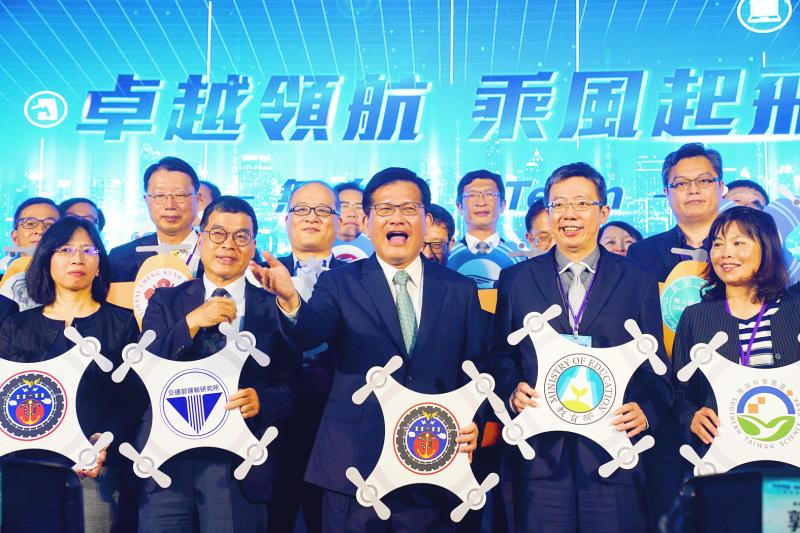The Ministry of Transportation and Communications (MOTC) is launching a national uncrewed aerial vehicle (UAV) contest as part of the nation’s strategy of tapping into the drone market as the technology is applied in new ways in an increasing number of fields worldwide.
Drone use has plenty of room to grow with 5G, the Internet of Things and big data, Minister of Transportation and Communications Lin Chia-lung (林佳龍) told a news conference in Taipei yesterday.
A “blue ocean” of potential UAV applications exists in the public and private sectors, Lin said, adding that the government has allocated NT$4.2 billion (US$145.76 million) from a smart transportation system project to fund drone applications.

Photo: CNA
Teams can compete in the national drone contest under the university student category or the business category, the ministry said.
Participants in the student category are tasked with developing ways of using drones to transport everyday supplies to the nation’s remote townships and outlying islands, while participants in the business category are tasked with developing solutions that fall under transportation or non-transportation applications.
On Jan. 22, after the teams have registered and submitted their proposals, the ministry would announce which teams qualify for the final round.
Those in the final round would be given about three months and guidance from professional drone developers to construct their proposals, with the teams’ drones competing in a final contest from April 19 to 23.
The winner would be selected one week after the final contest, with an awards ceremony to be held at the beginning of May.
The ministry oversees the operation of drones based on the Civil Aviation Act (民用航空法), but it wanted to accomplish much more than that, Lin said.
“We can form a national team to develop UAV technology and compete internationally,” he said. “Our job is to set up a platform for UAV developers to experiment with ways to use drones in various fields. All of them are welcome to participate in the UAV competition or help the agencies solve their problems using drones.”
After the Legislative Yuan passed the Unmanned Vehicles Technology Innovative Experimentation Act (無人載具科技創新實驗條例) in November 2018, the ministry’s science and technology board listed drone development as one of its key tasks.
After one year of preparation, the board has established a national team, or the “U Team,” to facilitate the development and application of UAV technology, Lin said, adding that the team members include government officials as well as experts from industry and academia.
Together, they have made progress in setting out government regulations, training personnel and building a geospatial information database, he added.
Although Chinese opposition kept Taiwan from participating in last year’s International Civil Aviation Organization Assembly in Montreal, Canada, the nation’s delegation on the sidelines of the meeting reported that many countries expressed an interest in local drone developments, from manufacturing to research and development and applications, he said.
The Directorate-General of Highways plans to use drones to facilitate bridge inspections, while Chunghwa Post expects to use drones for mail delivery, the ministry said, adding that UAV applications developed by the two agencies, which it oversees, could serve as examples for other projects involving drones.

Taiwanese scientists have engineered plants that can capture about 50 percent more carbon dioxide and produce more than twice as many seeds as unmodified plants, a breakthrough they hope could one day help mitigate global warming and grow more food staples such as rice. If applied to major food crops, the new system could cut carbon emissions and raise yields “without additional equipment or labor costs,” Academia Sinica researcher and lead author the study Lu Kuan-jen (呂冠箴) said. Academia Sinica president James Liao (廖俊智) said that as humans emit 9.6 billion tonnes of carbon dioxide compared with the 220 billion tonnes absorbed

The Taipei Mass Rapid Transit (MRT) Wanda-Zhonghe Line is 81.7 percent complete, with public opening targeted for the end of 2027, New Taipei City Mayor Hou You-yi (侯友宜) said today. Surrounding roads are to be open to the public by the end of next year, Hou said during an inspection of construction progress. The 9.5km line, featuring nine underground stations and one depot, is expected to connect Chiang Kai-shek Memorial Hall Station to Chukuang Station in New Taipei City’s Jhonghe District (中和). All 18 tunnels for the line are complete, while the main structures of the stations and depot are mostly finished, he

Taipei is to implement widespread road closures around Taipei 101 on Friday to make way for large crowds during the Double Ten National Day celebration, the Taipei Department of Transportation said. A four-minute fireworks display is to be launched from the skyscraper, along with a performance by 500 drones flying in formation above the nearby Nanshan A21 site, starting at 10pm. Vehicle restrictions would occur in phases, they said. From 5pm to 9pm, inner lanes of Songshou Road between Taipei City Hall and Taipei 101 are to be closed, with only the outer lanes remaining open. Between 9pm and 9:40pm, the section is

China’s plan to deploy a new hypersonic ballistic missile at a Chinese People’s Liberation Army Rocket Force (PLARF) base near Taiwan likely targets US airbases and ships in the western Pacific, but it would also present new threats to Taiwan, defense experts said. The New York Times — citing a US Department of Defense report from last year on China’s military power — on Monday reported in an article titled “The missiles threatening Taiwan” that China has stockpiled 3,500 missiles, 1.5 times more than four years earlier. Although it is unclear how many of those missiles were targeting Taiwan, the newspaper reported